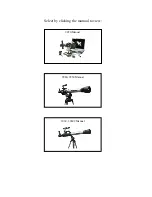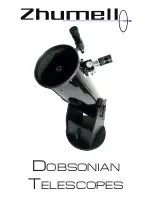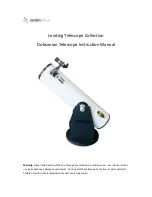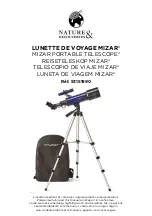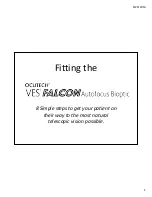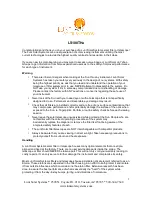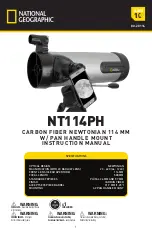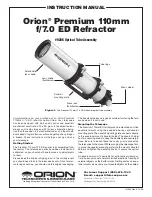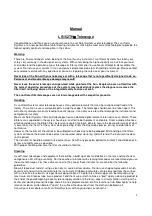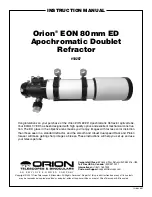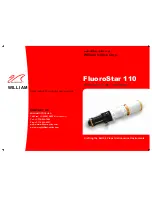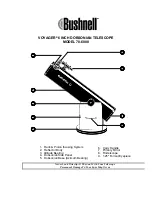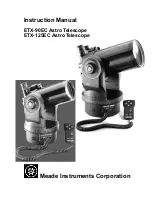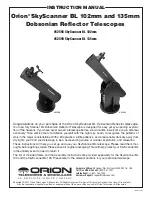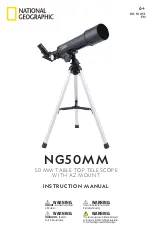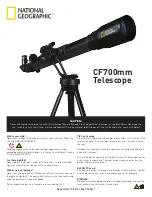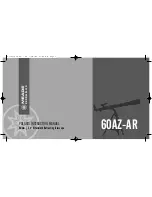2
D)
HOW TO USE THE TELESCOPE
Our telescope offers an extensive selection of parts and accessories
for your telescope to further enhance the exploration of worlds beyond.
As well, it is a precision optical instrument certain to give many years
of enjoyment and entertainment.
i. Viewing
What you see through a telescope and how accurate you see it is a
function of three factors ;
•
Power / Magnification
•
Brightness
•
Resolution / Clarity of image
It is a common misunderstanding that the more power you have, the
better it is. Indeed, essential functions of a telescope are to magnify
the image, or give the effect of being closer to object of observation.
However, there are limits to how much power to use effectively. With
every increase in magnification, there is a corresponding reduction of
brightness and resolution. Too much magnification and the image will
become dim and blurry so that the features of the object become
vague. For best view of any astronomical body, you must strike a
balance between the three viewing qualities.
Furthermore, with every increase in power, there is a decrease in field
of view. The field of view is the circle of sky you see as you look
through your telescope. The more you increase magnification, the
smaller that circle becomes. You will also notice that celestial bodies
seem to move fast across the field of view even at low powers. That
movement is still more recognizable at high powers. High power will
provide some dramatic views of lunar or planetary features, but can
also be somewhat frustrating until you acquire a certain level of
expertise at tracking objects smoothly.
ii.
Power Strength : Selecting The Eye Lens
Power means the ability of telescope to increase an image, or
appear to bring the image closer to the viewer. Value of magnifying
power is distinguished by a number followed by an X (read power).
Therefore, If you view an object at 125X, you are seeing it as though
you are 125 times closer to that object.
Power is calculated by dividing the focal length of objective lens of
your telescope by the focal length of the eye lens you choose. The
focal length of the eye lens is usually indicated on the eyepiece itself.
For example : 4mm
500 mm (focal length of objective lens)
Example: ------------------------------------------------------- = 125 X
(power)
4 mm (focal length of eyepiece)
The longer the focal length of the eyepiece, the less the magnifying
power of the telescope. Whereas the shorter the focal length, the
greater the power. Therefore, when choosing an eye lens to insert
the diagonal prism, you are actually selecting what magnifying
power you wish to use for inspection.
E)
USING THE SMARTPHONE ADAPTER
Components of the Smartphone Adapter
1.
Adjustable arm
2.
Smartphone holder
3.
Bracket
4.
Quick release lever
5.
Arc
6.
Small knob
7.
Eyepiece adapter
8.
Large knob
9.
Swing arm
10.
Small screw
i.
Attach The Smartphone To The Adapter
1) If the telescope clip (lower half) is connected to the smartphone
holder, separate them by pressing the quick release lever (4) and
sliding out.
2)
Loosen the large knob (8) at the back of the adaptor and put the
smartphone on it with face up.
3) Adjust the position of the horizontal arm (1)
to fit the width of the smartphone and
tighten the large knob (8) just enough
to keep the phone in position.
4) Align the centre of the adaptor hole of the
swing arm (9) to the smartphone camera.
Tighten the screw so that the smartphone is
securely held in place.
5) Loosen the small knob (6) on the base of the clip and open the arc
of the ring (5).
6) Attach clip to the telescope
tube with the flat side in upper
position.
7) Close the ring, secure
by tightening the small knob (6).
1
6
4
7
3
5
2
9
8
10

